Managing Type 1 Diabetes in children can feel daunting, but with practical strategies, parents can support their child’s health and happiness. This guide covers key tips for parents of kids with Type 1 Diabetes, including daily routines, carb counting, and emergency preparedness.
What is Type 1 Diabetes in Children?
Type 1 Diabetes (T1D) is an autoimmune condition where the pancreas stops producing insulin. Unlike Type 2, it’s not caused by lifestyle. Kids need insulin therapy lifelong. Early signs include frequent urination, extreme thirst, weight loss, fatigue, and blurred vision. Seek medical help if symptoms appear.
Key Facts on Pediatric Type 1 Diabetes Management
- Not preventable or curable.
- Requires insulin via injections or pumps.
- Involves constant blood sugar monitoring.
How to Build Knowledge for Type 1 Diabetes Care in Kids?
Education empowers parents. Learn blood sugar monitoring, insulin types (rapid-acting, long-acting), carb counting, and signs of hypoglycemia/hyperglycemia.
Resources for Parents:
- Online programs.
- Books on childhood diabetes.
- Support groups.
Creating a Daily Routine for Children with Type 1 Diabetes
Consistency helps kids thrive. Include scheduled blood sugar checks (before meals, bedtime), insulin doses, balanced meals, and exercise. Use Continuous Glucose Monitors (CGMs) for real-time data.
Blood Sugar Checks Frequency for Kids
Test 4-10 times daily or use CGM to reduce pricks.
Meal Planning and Carb Counting for Type 1 Diabetes in Children
Carbs impact blood sugar most. Count them using apps or labels. Build meals with fiber-rich foods, proteins, and fats to avoid spikes.
Healthy Snacks Ideas:
- Nuts, cheese, eggs.
Kids can eat sweets moderately with insulin adjustments.
Encouraging Physical Activity in Kids with Type 1 Diabetes
Exercise lowers blood sugar but needs monitoring. Check levels pre-activity, have fast-acting carbs ready. Safe options: swimming, cycling, sports.
Is Exercise Safe for Children with T1D?
Yes, with precautions and doctor approval.
Partnering with School for Type 1 Diabetes Management
Create a 504 Plan for accommodations. Educate staff, provide a kit with supplies, insulin, snacks.
Supporting Emotional Well-being in Children with Type 1 Diabetes
Kids may feel anxious or different. Normalize T1D, encourage talking, seek therapy if needed. Connect via camps or groups.
How to Help Child Feel Normal with Type 1 Diabetes?
Promote favorite activities, peer connections.
Emergency Preparedness for Pediatric Type 1 Diabetes
Plan for lows or illnesses. Keep glucagon, extra insulin, glucose tablets, doctor contacts.
What to Do for Low Blood Sugar in Kids?
Give juice or tablets, follow with protein snack.
Leveraging Technology for Type 1 Diabetes in Kids
Use CGMs, insulin pumps, tracking apps for accuracy.
People Also Ask: Common Questions on Managing Type 1 Diabetes in Children
Q: Can my child eat sweets with Type 1 Diabetes?
A: Yes, in moderation with carb counting and insulin.
Q: How often should blood sugar be checked in children with T1D?
A: 4-10 times daily or via CGM.
Q: What are signs of hypoglycemia in kids?
A: Shaking, sweat, confusion—treat immediately.
Q: How does carb counting work for pediatric diabetes?
A: Calculate grams in food to dose insulin accurately.
Q: Are insulin pumps better for children with Type 1 Diabetes?
A: They offer precise delivery; discuss with doctor.
Q: What school accommodations for kids with T1D?
A: Testing access, snacks, trained staff via 504 Plan.
Q: How to handle hyperglycemia in children?
A: Check ketones, adjust insulin, hydrate.
Q: Best apps for Type 1 Diabetes management in kids?
A: MySugr, Dexcom for tracking.
Q: Emotional support resources for parents of T1D kids?
A: JDRF, support groups, counselors.
Q: Preventing complications in childhood Type 1 Diabetes?
A: Consistent monitoring, A1C checks, healthy habits.



